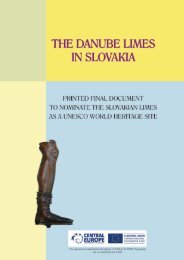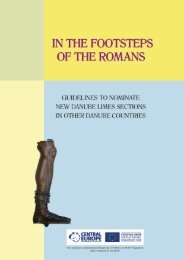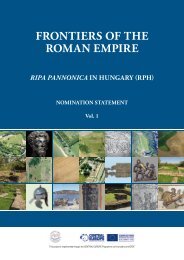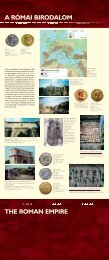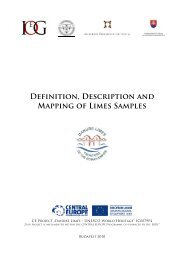Click here for the PDF version! (15,2 MB) - Danube Limes
Click here for the PDF version! (15,2 MB) - Danube Limes
Click here for the PDF version! (15,2 MB) - Danube Limes
You also want an ePaper? Increase the reach of your titles
YUMPU automatically turns print PDFs into web optimized ePapers that Google loves.
An agreement has been concluded on 12th August 2009, between <strong>the</strong> local<br />
government of Paks and <strong>the</strong> Town Museum of Paks, to carry out archaeological works<br />
at Lussonium, as well as preserving, documenting and exhibiting archaeological finds.<br />
Following <strong>the</strong> acceptance of <strong>the</strong> contract, a geodesic test has been carried out at <strong>the</strong><br />
local government-owned area, allowing <strong>the</strong> accurate allocation of <strong>the</strong> two distinct<br />
excavation sites within <strong>the</strong> territory.<br />
Excavation in 2009<br />
Excavation works started in 2009, on <strong>the</strong> nor<strong>the</strong>rn part of <strong>the</strong> so-called 'Bottyánsánc',<br />
at a lowly situated area just north of <strong>the</strong> outermost north-western fossa. On <strong>the</strong> grounds<br />
of this site a visitor centre will be built. Until now, no artefacts were found in <strong>the</strong> 5 x<br />
10 m unit at <strong>the</strong> excavation site. Never<strong>the</strong>less, fur<strong>the</strong>r excavations are planned to be<br />
conducted in <strong>the</strong> future by expanding <strong>the</strong> excavation site to <strong>the</strong> north and to <strong>the</strong> south.<br />
This would enable <strong>the</strong> complete exploration of <strong>the</strong> location of <strong>the</strong> new visitor centre.<br />
In addition, excavation works at last year’s site - situated at <strong>the</strong> north-eastern part of<br />
Lussonium castellum, around <strong>the</strong> inner side of <strong>the</strong> nor<strong>the</strong>rn walls - have been carried<br />
on. A 10x10 m (ca. 100 m2) excavation trench was opened <strong>here</strong> last year, which was<br />
fur<strong>the</strong>r studied this year. Since <strong>the</strong> beginning of this year’s operations, experts have<br />
managed to identify <strong>the</strong> exact width of <strong>the</strong> North-South Roman road that passes<br />
through <strong>the</strong> centre of <strong>the</strong> military <strong>for</strong>t. The foundations of a building linked to this road<br />
from <strong>the</strong> east were also discovered. Apart from <strong>the</strong> previous objects, several o<strong>the</strong>r<br />
artefacts were found, including costumes, personal articles and ceramic bowls. These<br />
date back to between <strong>the</strong> first and fourth centuries. The most notable artefact was<br />
bronze emperor statue fragment, which was found during <strong>the</strong> end of <strong>the</strong> excavation<br />
period in <strong>the</strong> vicinity of a layer of burnt soil. Its uniqueness is underlined by its size<br />
and ornamentation. The artefact was transported to <strong>the</strong> Town Museum of Paks w<strong>here</strong>,<br />
after a preliminary cleaning process, it could be presented to <strong>the</strong> general public at a<br />
national press conference.



